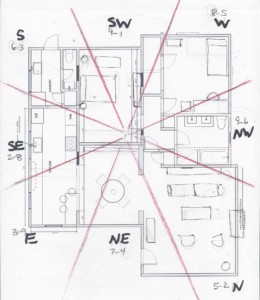
When first learning classical Feng Shui, you are impressed with how important it is to use a to-scale floor plan and you also learn about the Luo Shu grid. This Luo Shu gridding is superimposed over a real floor plan so that you can identify the correct directional zones for a home or business.
The floor plan is your map and so is the luo shu grid! Now, Westerners are used to seeing depictions of maps with North on the top. The Chinese are familiar with seeing South on the top of a map. This goes back to Yin Yang Theory and the very Yin Yang symbol, where the thickest part of the white side should be on the top. This represents high noon, summer, and the direction of south. The lower part of the Yin Yang symbol should be presented with the thickest black part on the bottom, representing night, winter and the direction of north.
And while it is easy to start seeing south on the top of the Luo Shu grid, fact is we have houses and buildings which face all the directions. Our depictions of floor plans are usually aerial views, from above looking downward. It doesn’t matter how you position the floor plan or draw it on a piece of paper.
The floor plan example in this article shows a northeast facing house, where the northeast has been depicted at the bottom of a page. If I was trying to adhere to placing North on the top of a page, I would have to angle the floor plan on the page and that would look awkward.
You can place a south facing house where the south side is toward the top of the page, bottom of page, or facing left or right on the page. The only thing you need to remember is that the luo shu grid must turn along with it! The actual directions of the luo shu gridding must corroborate with the floor plan.
I thought this would be a relevant article since some of my beginner’s students have tried to demonstrate luo shu gridding on the test, where they keep the original “south on top format,” no matter what direction the structure actually faces. There are also houses which face the sub-cardinal directions of SW, NW, NE or SE. The luo shu must then turn and accommodate the real directions.
It would behoove any beginner student to learn quickly how to grid out a house that faces any direction and drawn any which way on a page. For instance, I can draw a northeast facing house facing the top of the page, bottom of page, facing left side or right side of the page. I just need to then also match up the real directions with the actual floor plan.
Author: Kartar Diamond
Company: Feng Shui Solutions ®
From the School Newsletter Blog Series
